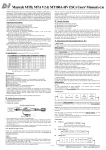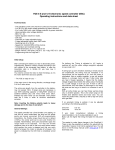Download LED Programming Card User`s Manual for ICE series(V.Double key)
Transcript
LED Programming Card User’s Manual for ICE series With the programming card, you can set all functions of our ESC. The prominent feature is its precise cutoff voltage adjustment for respective number of cells for the two types of Lithium battery prevailing on the market. Furthermore, the timing, different brake modes, governor modes and the accurate throttle stick positions can be set and adjusted by the programming card. All settings of the ESC can be read by the card, while it is impossible by throttle stick programming. Operating Instructions Disconnect the flight battery from the speed controller. Disconnect the cable from the receiver (or opto-coupler), and connect it to the upper right connector (ESC pins) on the ProgCard II. The cable has 3 colors wires: the brown wire connect to the left cathode pin (brown), the red wire connect to the middle +5V pin, the orange wire connect to the right signal pin. You need to prolong the wires of OPTO ESC, because the ProgCard II needs to get power supply from the receiver. Now connect the motor with ESC. Those ESCs with BEC output is ready for programmable by ProgCard II now. (For those ESCs without BEC output, the ProgCard II needs to get power supply from the receiver.) While the LEDs of the ProgCard II light up, you could hear 6 beeps (short melody) from the ESC and motor. Setting Instructions Press ITEM button (on the left bottom of ProgCard II) to circularly select No. 1-7 Settings. Press both ITEM and VALUE buttons (at a time) to circularly select No. 8-14 Settings. During your selection, the Setting No. shows on the upper ITEM screen, while the ESC current parameter (under this Setting No.) shows on the upper VALUE screen. If 2 parameters occur (under certain Setting No.), they would be circularly showed on the VALUE screen. Press VALUE button to set different parameters easily, and then press ENTER button to save settings. Level 1 1 Shortly after the ESC current settings been read, you can get into Level 1 starting with the Timing “1” indicator. You could press “ITEM” to select from the menu, and see the ESC current setting on “VALUE” screen. Press “VALUE” to set new parameters, and then press “ENTER” to save new settings. The ESC will acknowledge with a positive beep to confirm saving the setting (a low and a high tone beep), while send out a negative beep if any settings cannot be saved correctly (1 low tone). All functions can be adjusted in above-mentioned way. When setting certain parameter, the other parameters would not change. If adjusting Lipo battery type, please always remember to adjust the cutoff voltage and the cell count accordingly. 2 and 3 cells battery can be recognized automatically by the ESC itself, so the cell counting starts from 4 cells on the ProgCard II. The programming of the cell count is saved in the ESC. Connecting a different cell count battery pack would lead to wrong under voltage detections. Reset the battery type (LiPo / LiFe) will delete the saving of cell count, then the ESC will reset to automatic cell count detection By activating the LiFe cell type (LiFePO4), the cutoff voltage is reduced 0.7V per cell. Cutoff voltage (Voltage High Limit) for LiFe battery is 2.2V to 2.7V per cell. Cutoff voltage (Voltage Low Limit) for LiPo is 2.9V to 3.4V per cell. In the NiMh mode, neither the cutoff voltage nor the cell count needs to be programmed. Slowdown occurs automatically due to the battery voltage during connection. (Therefore, please use only fully charged NiMh batteries) Beep short shortens the start-up beep. Rev. (Navy) Forward and reverse activation (only for Navy/ Boat ESC). Throttle Position Brake off (without brake) For the throttle stick range calibration, please connect the enclosed extension cable from the receiver to the upper right connector (ESC) of the ProgCard II. First, turn on the transmitter, and put the throttle stick on stop position. Press “ITEM” button to select Menu No.7, and press “VALUE” button to select (3), and then press “ENTER” to save “STOP” setting. Second, put the throttle stick on full speed position. Press “ITEM” button to select Menu No.7, and press “VALUE” button to select (4), and then press “ENTER” to save “FULL SPEED” setting. Throttle Position Brake on (with brake) 2 The brake starts 10% below the stop position, so the throttle stick range needs to be calibrated a bit shorter. For that put the throttle stick on 10% power ( about 3 notches away from stop) and proceed with the above calibration. Alternatively you can also learn in the complete stick range, after having set the servo travel from 10% to 100%. After calibration you need to come back to 0% - 100% to be able to reach the brake position. For transmitters with -100 to +100% servo travels you need to program -80% to +100% for calibration and come back to -100, +100% after calibration. Brake smooth, middle, hard These three steps are only for folding air-screw propeller! F3A Brake This function allows to adjust the F3A brake intensity without any brake grades. It can reduce the motor RPM while the plane flies downward. You need the extension cable again, like described above, select the F3A Brake LED. For example, need 50% brake, put the throttle stick on half position and press “ENTER” to confirm. Likewise for 75% brake, put the throttle stick on 3/4 position, etc. For the throttle stick range calibration, the stop position should be 10% lower because the opto-coupler has a propagation delay of 50 MicroSecond (µs) and thus the stop point is shifted. Level 2. All other functions like the Governor Mode can be programmed by the level 2 of the ProgCard II. Press both “ITEM” and “VALUE” buttons simultaneously to get into Level 2. By pressing the two buttons again you could get back to level 1. Act. Freewheel (active Freewheel) allows best efficiency in the partial load range whereby the ESC remains clearly cooler Governor Mode (Gov. / Gov. Store) For the use of the governor mode in a helicopter, the throttle stick range or the throttle curve (100%) must have been calibrated as described in level 1. A throttle curve point of e.g. 70% corresponds to a completely determined head speed, which is held as long as possible for the ESC due to the battery voltage. If the battery voltage drops below a certain level, even a full power setting won’t be able to reach the demanded head speed if the voltage doesn’t allow it. If this appears to be the case at the end of a flight, the throttle curve should be reduced accordingly. For both governor modes: don’t modify the P-gain, I-gain and PWM switching rate initially! If you do so the ESC parameters would also be modified. Governor Mode is the classical head speed regulation for helicopters. The setting of the throttle curve should be around 60 to 80% of the full throttle range. 3 The ESC learns at every start the correspondence of the throttle curve and the head speed. That is why there is a short head speed increase just before reaching the demanded speed. This can disturb the tail, but a slight pitching will settle things down as the helicopter is not “glued” to the ground anymore. Gov. store is an extended helicopter feature, where the correspondence of the throttle curve and the head speed is done only at the first start (learning procedure). This head speed is stored so that at every later start the head speed will remain exactly the same. If the learning wasn’t successful or wrong, you can reset the learning by selecting once again the Gov. Store. Operating instructions Set the throttle curve to the full throttle range (eg.80%). Start the ESC and stop for a while when it reach the highest head speed. A fault RPM will be noticed. Turn off the ESC and disconnect the battery. Reset the throttle curve at the same or lower throttle range when connecting battery next time. If unsuccessful or fault to learning throttle curve, you could reset by reselecting Gov. Store. The learning can even be done with nearly or exact 100%. Doing this will improve the correspondence of the throttle curve to the actual head speed. But please be careful as 100% learning could lead to very high head speeds, and anyway don’t forget to set back the throttle curve to avoid flying with full power. Fast (Gov.) can be selected along with both governor modes. This feature increases the control loop frequency and can be used above a magnetic pole commutation frequency of 80000 per minute. (poles/2x motor rpm) To try only if the speed control is not completely satisfactory. The advantages are that the P and I gains can be reduced without getting a weak speed control. Important notice for the governor fine tuning. The governor software default parameters are adapted to most setups. Nevertheless, if necessary the following parameters (P and I gain) can be adjusted. P-Gain is the proportional gain. According to this parameter, head speed variations will be regulated harder or softer. Practically, it is the force of the control loop. (- weaker, + stronger). With smaller helis, less then 1m rotor diameter, this parameter shouldn’t exceed 1 meter. 4 With larger diameters you can go to the max. A bad adjustment is reflected by a wagging tail. I-Gain is the integral gain. According to this parameter, remaining head speed deviations are corrected faster or slower. It is an important complement to the P term: The P control is fast, but cannot recover completely the demanded head speed as it needs this deviation to exist. The I-term remembers this small remaining deviation and is able to remove it completely thanks to its “memory” Both parameters should be adjusted simultaneously. If you can increase the P-term, you should generally also be able to increase the term and vice versa. Too high settings can lead to a resonance between tail gyro and governor. The result is then a very noisy or even wagging tail that could lead to an out of control situation. Therefore the adjustments on P and I should be done in small steps. By selecting again one of the governor modes, these parameters are reset to their default values. Startup Speed is the spool up speed for helicopters and planes. PWM Frequency is the switching rate used for partial load operation. With low frequencies the losses are reduced, but the motors run slightly rougher. With high frequencies, it is the opposite. The optimum frequency may be found in the user manual of your motor. Startup Power. The higher the startup power, the faster and harder is the start. With small propellers it isn’t a problem, but with large ones, it can lead to a fairly rough startup behavior. Before you disconnect the ProgCard from the ESC, you can verify your programmed settings by scrolling through each menu line. But this is only a history of your recent settings and doesn’t reflect the other settings of the ESC. For that you have to read it in again. Hint: When you select “ITEM” No.14 and press “Enter”, the ESC will be read back again. This is a way to re-manage the ESC settings without disconnecting the power (for only ESC with BEC output). After programming, please first disconnect the flight battery and then reconnect the ESC plug into the receiver. 5

















